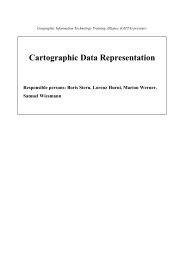Print (PDF) - GITTA - Geographic Information Technology Training ...
Print (PDF) - GITTA - Geographic Information Technology Training ...
Print (PDF) - GITTA - Geographic Information Technology Training ...
Create successful ePaper yourself
Turn your PDF publications into a flip-book with our unique Google optimized e-Paper software.
Discrete Spatial variables<br />
1.5. Regionalization<br />
This unit will introduce how to delineate or define a boundary of a spatial object (non pre-existed) and<br />
assign a value (nominal, ordinal and ratio) to it or label a pre-existed spatial object Such as your farm<br />
based on point sample measurements of particular phenomena, such as soil texture and assign a value or label,<br />
such as sandy clay loam to your farm through the process of regionalization 1 . At the end of the unit, you<br />
will learn how to assign or label the spatial objects (pre-existed or non pre-existed) using the regionalization<br />
concept. When the spatial distribution of phenomenon properties is assumed as discontinuous, it is important<br />
to consider several situations for assigning properties to features. Most of the time properties of a phenomenon<br />
are measured at specific locations (measurement sites). This set of data is called sample. From these point<br />
feature measurements thematic properties should be assigned to a set of spatial features.<br />
1 Regionalization can be defined as: "The process of generalizing properties of a phenomenon throughout space, based on a set of<br />
observations". This definition is common to both continuous and discrete spatial distributions.<br />
http://www.gitta.info - Version from: 5.5.2010 29
















